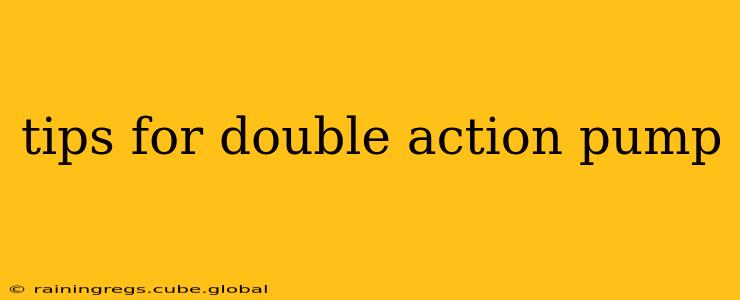Double action pumps are powerful and versatile pieces of equipment used across various industries. Their efficiency stems from their ability to pump fluid during both the forward and backward strokes of the piston. However, maximizing their performance and longevity requires understanding and implementing proper operating and maintenance procedures. This guide will cover essential tips, addressing common questions and concerns.
How Does a Double Acting Pump Work?
Before diving into tips, it's crucial to understand the mechanism. A double-acting pump utilizes a reciprocating piston within a cylinder. Fluid is drawn into the cylinder on one side of the piston during the intake stroke, and simultaneously, fluid is discharged from the opposite side of the cylinder. The reversal of the piston's movement repeats this process, resulting in continuous fluid flow. This contrasts with single-acting pumps, which only pump during one stroke.
What are the Different Types of Double Action Pumps?
Several types exist, each suited for specific applications. These include:
- Plunger Pumps: These use a plunger instead of a piston, ideal for high-pressure applications.
- Diaphragm Pumps: Employing a flexible diaphragm, these pumps are suitable for handling viscous or abrasive fluids.
- Reciprocating Pumps: The most common type, characterized by the back-and-forth movement of the piston.
How Often Should I Maintain My Double Action Pump?
Regular maintenance is paramount. The frequency depends on factors like usage intensity, fluid type, and operating conditions. A general guideline suggests inspections and lubrication at least monthly, with more thorough servicing (including potential part replacements) every six months to a year.
What are the Common Problems with Double Action Pumps?
Several issues can impact performance:
- Leaks: These can occur at various points, including seals, valves, and packing glands. Regular inspection and timely replacement of worn parts are crucial.
- Low Output: This might indicate issues with valve operation, piston wear, or insufficient priming.
- Excessive Vibration or Noise: This often suggests bearing wear, imbalance, or cavitation (formation of vapor bubbles).
- Overheating: This can be caused by insufficient lubrication, excessive pressure, or blockages.
How Can I Prevent Leaks in My Double Action Pump?
Leak prevention is vital for both efficiency and safety. Regular inspection of seals and packing glands is critical. Replace worn components promptly. Ensure proper lubrication and avoid over-tightening fittings, which can damage seals.
How Do I Troubleshoot My Double Action Pump?
Troubleshooting requires a systematic approach. Begin by checking for obvious issues like leaks, loose connections, or blockages. If the problem persists, consider consulting a service manual or contacting a qualified technician. Recording operating parameters (pressure, flow rate, temperature) can help pinpoint the cause.
How Do I Choose the Right Lubricant for My Double Action Pump?
The choice of lubricant depends heavily on the pump's design, the fluid being pumped, and operating conditions. Consult the pump's manufacturer's recommendations for specific lubricant types and viscosities. Using the wrong lubricant can lead to premature wear and failure.
What are the Safety Precautions When Operating a Double Action Pump?
Safety is paramount. Always follow the manufacturer's safety guidelines. Ensure proper grounding and shielding to prevent electrical hazards. Wear appropriate personal protective equipment (PPE), such as safety glasses and gloves. Never operate the pump if you suspect a malfunction.
This guide provides a comprehensive overview of tips for double action pump operation and maintenance. Remember, proper care ensures optimal performance, longevity, and safety. Always consult your pump's specific manual for detailed instructions and safety procedures.
